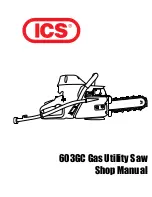
Model G0715P (Mfg. 4/11+)
-69-
Some woodworkers prefer to offset the rear of
the fence
1
/
64
" from the blade, as shown in
Figure
116, to help prevent the workpiece from binding
and burning.
The argument is that this offset adjustment reduc-
es the chance of kickback by alleviating potential
binding that may occur between the backside of
the blade and fence. The tradeoff is slightly less
accurate cuts.
Figure 116. Adjusting fence with a
1
⁄
64
" offset.
X"
X" +
1
/
64
"
Extra Space
to Prevent Binding
(Optional)
X = Your Measurement
Blade
6. Examine how the fence lines up with the
miter slot along its length.
—If the fence and miter slot are flush from
front to rear, as shown in
Figure 115A,
proceed to
Step 8.
—If the rear of the fence overlaps the miter
slot, as shown in
Figure 115B, the fence is
misaligned. Proceed to to
Step 7.
7. Remove the fence, then alternately loosen
and tighten the rear fence set screws in equal
amounts to adjust the rear of the fence until it
is parallel with the miter slot.
8. Loosen both front lock nuts (see Figure 112
on
Page 67). Tighten the adjustment screws
so they just touch the fence tube, back off the
screws
1
⁄
2
turn, then tighten the lock nuts.
Optional Offset Fence Adjustment
To offset the fence:
1. DISCONNECT SAW FROM POWER!
2. With a felt tip pen, mark one saw tooth and
rotate the blade so this tooth is positioned at
the back of the blade.
3. Place the fence on the table, and clamp the
fence to the table.
4. Measure the distance between the tooth and
the fence face, as shown in
Figure 116.
5. Remove the fence, and adjust the rear set
screws as previously discussed to achieve an
offset of
1
/
64
" between the marked tooth and
the fence face.
6. Re-install the fence and measure the dis-
tance again between the marked tooth and
the fence face. The rear measurement should
be
1
/
64
" greater than previously measured in
Step 4.
Содержание G0715P
Страница 18: ... 16 Model G0715P Mfg 4 11 Hardware Recognition Chart ...
Страница 88: ......
















































